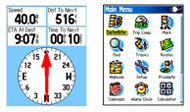Navigating the world has become deeply intertwined with GPS technology. We rely on those little blue dots and directional arrows to get us from point A to point B, often without a second thought. But the user interface (UI) behind those directions is constantly evolving, driven by advances in technology and changing user expectations. Predicting future trends in GPS UI design requires understanding current limitations and leveraging emerging technologies to create truly intuitive and helpful navigation experiences. This article dives into the evolving landscape of GPS user interfaces, exploring potential trends and their implications.
The Rise of Contextual Awareness: Beyond Simple Navigation

Current GPS systems often feel limited by their single-minded focus on point-to-point navigation. Future interfaces will be significantly more contextual, understanding not just *where* you’re going but *why*. Imagine a system that automatically suggests alternate routes based on real-time traffic, *and* considers your calendar appointments. Need to pick up dry cleaning on the way home? A smart GPS could integrate with your schedule and seamlessly incorporate that stop into your optimized route, even offering real-time updates on the dry cleaner’s opening hours. This level of contextual awareness requires seamless integration with other apps and services, a trend already starting to take hold.
Augmented Reality Navigation: A More Immersive Experience
Augmented reality (AR) is poised to revolutionize GPS navigation. Instead of simply seeing a map on your screen, imagine seeing directions overlaid directly onto your real-world view, through your phone’s camera or AR glasses. This could mean seeing directional arrows projected onto the street in front of you, or having building names highlighted as you approach them. While the technology is still maturing, the potential for AR to create a more intuitive and less distracting navigation experience is enormous. Think about reducing the need to constantly look down at your phone – a major safety concern for drivers and pedestrians.
AI-Powered Personalization: Learning Your Habits and Preferences

Artificial intelligence (AI) will play a crucial role in shaping future GPS UIs. AI-powered systems can learn your driving habits, preferred routes, and even your risk tolerance. This personalization goes beyond simply remembering your home and work addresses. A smart GPS could, for example, automatically suggest a slightly longer but less congested route if you’re running late for an important meeting. It could also learn to avoid certain types of roads (e.g., toll roads) based on your past behavior. The key is creating a system that adapts to your individual needs and preferences over time, making navigation increasingly effortless and efficient.
Multimodal Interaction: Voice, Gesture, and More

The days of solely relying on touchscreens for GPS interaction may be numbered. Future interfaces will likely embrace multimodal input, allowing you to interact with the system using a variety of methods. Voice control is already common, but expect more sophisticated voice recognition that understands nuanced commands. Gesture controls could allow you to easily zoom, pan, and rotate the map without taking your eyes off the road. Even haptic feedback could provide subtle cues, guiding you subtly towards your destination without requiring constant visual attention.
Improved Offline Functionality and Data Management
Not everyone has access to reliable cellular data everywhere. Future GPS UIs will need to offer robust offline functionality, allowing for reliable navigation even in areas with limited or no connectivity. This requires efficient map caching and download management, ensuring that users always have access to the information they need. Furthermore, privacy concerns are paramount. Smart GPS systems must handle user data responsibly, providing transparent control over data collection and usage. Secure storage and encryption of location data will be essential for building user trust.
Addressing User Pain Points: Clarity and Simplicity

Many current GPS UIs suffer from cluttered interfaces and confusing instructions. Future systems should prioritize clarity and simplicity. This means reducing visual clutter, using clear and concise language, and providing intuitive controls. The goal should be to make navigation effortless and stress-free, removing the frustration often associated with complex interfaces. A focus on user feedback and iterative design will be crucial for achieving this.
The Future is Seamless Integration
Ultimately, the future of GPS UIs lies in seamless integration with other aspects of our lives. Imagine a system that seamlessly connects with your smart home, notifying you of deliveries or informing you of potential traffic delays that might impact your commute. This interconnectedness will transform navigation from a simple task into a valuable part of a larger, more integrated ecosystem. This also includes integrating with other forms of transportation, providing multimodal journey planning options, adapting to various transportation modes (walking, biking, public transport).
Conclusion: Navigating the Future of Navigation
The trends outlined above point towards a future where GPS navigation is not just about getting from A to B, but about creating a more intelligent, personalized, and intuitive experience. As technology continues to advance, we can expect even more innovative and user-friendly GPS interfaces that seamlessly integrate with our daily lives, making navigation more efficient, safer, and enjoyable.


